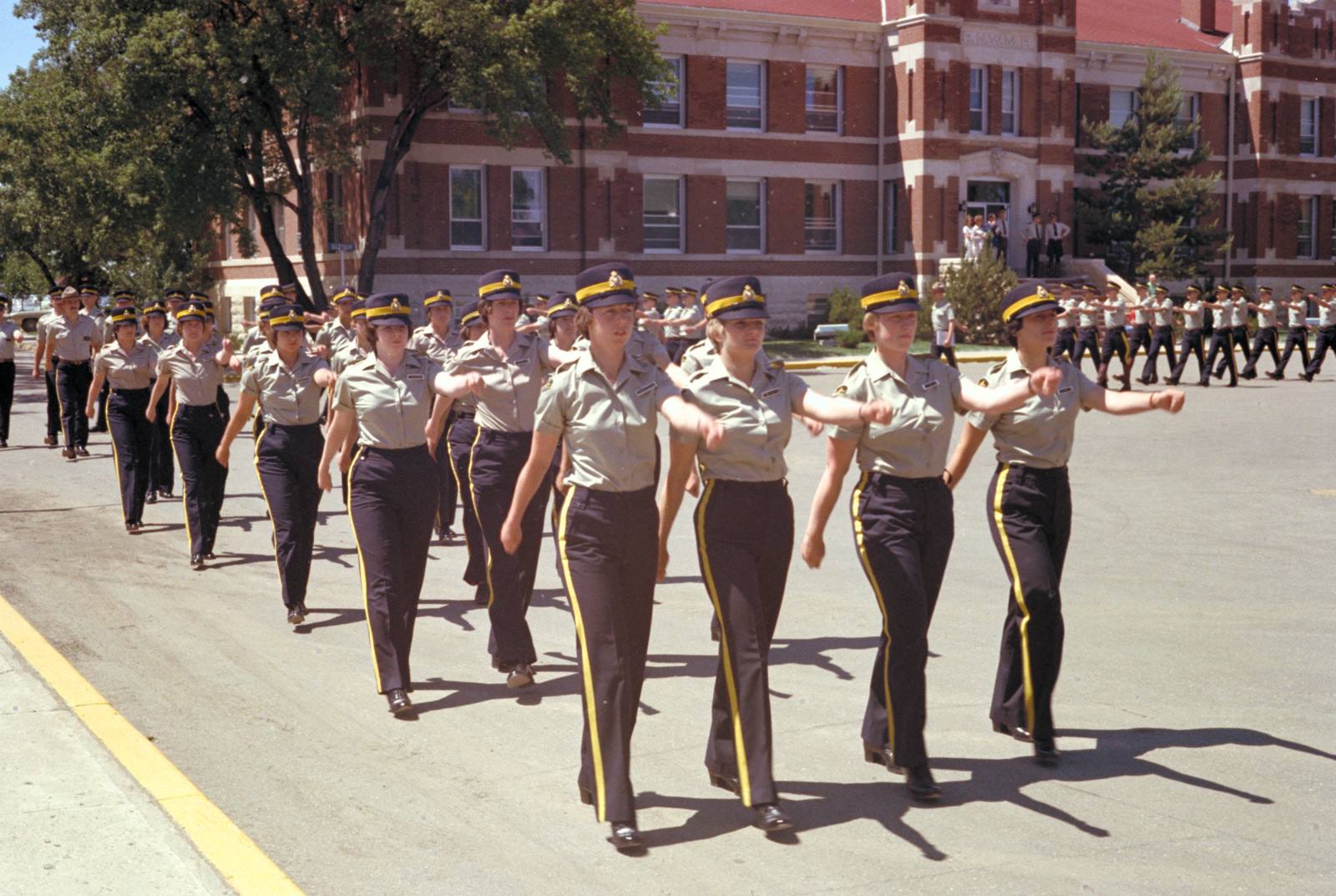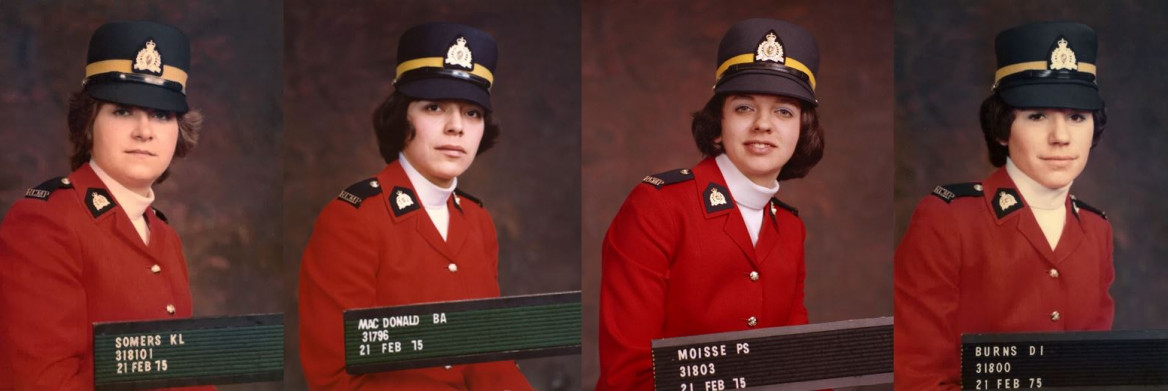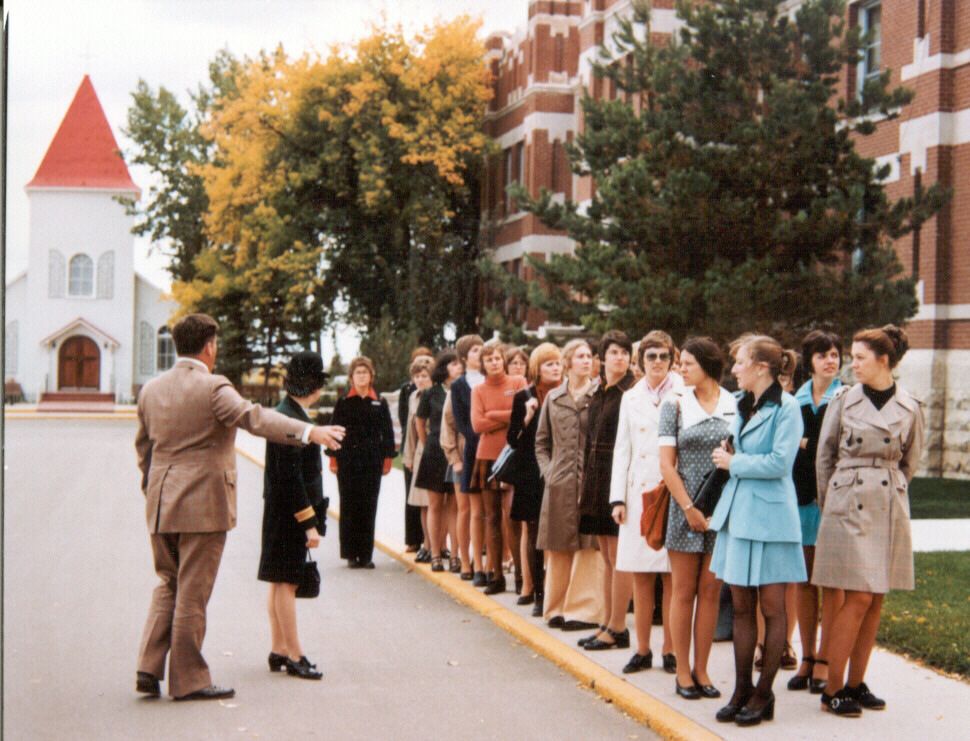On Sept. 16, 1974, 32 women from across Canada made history when they were sworn in as the first female cadets in the RCMP. Known as Troop 17, they pushed through many challenges including training with the short-lived purse and proving themselves in a male-dominated field. Gazette writer Meagan Massad spoke to four members of Troop 17 — Corporal Karen Adams, Commissioner Bev Busson, Constable Patricia Clark and Corporal Donna Morse — to hear how they overcame obstacles, gained credibility, and paved the way for equal opportunity in policing.
- Why did you join the first troop of female recruits in 1974?
-
Adams: After high school, I wanted to become a social worker but I realized after working in the field that it wasn't the best fit. I became interested in criminology and deviance, and started considering becoming a police officer. Then, in 1974, the RCMP announced they were hiring women, so I applied.
Clark: I'd always been fascinated with police work but in the 1970s, there weren't a lot of options for women. But, around that time, the RCMP announced it was hiring women. I figured I may as well start with the best, so I sent my application to the RCMP.
Busson: I'd been on a path to become a teacher. But I found out in my life I'm a bit of an adrenaline junkie. Teaching wasn't quite cutting it. When I heard about the RCMP, I thought to myself 'Wow, that sounds exciting!' I thought it would be an extraordinary adventure, which far surpassed any of my life's expectations.
Morse: In 1973, I was working in a bank and noticed I wasn't getting the same opportunities as my male counterparts. At the time, my father was a police officer with the Calgary police. It was still a man's world back then but I believed if I became a police officer, I'd have more control of my own career. In May of '74 I saw the RCMP was hiring women. Applying and getting accepted into Depot was a whirlwind experience.
- Is there a memory from the training that stands out for you?
-
Adams: Well, a troop is made of a marching formation, and there were 32 of us women in the first troop. Our uniforms were very different from the male troops. The men had boots and breaches and had cadence (made a loud rhythmic sound) on the hardwood floors when they marched. On the last drill class before Christmas break in 1974, Troop 17 decided we were also going to make our cadence heard. We put silver bells on our Oxfords [one of the issued shoes for women]. When our drill sergeant came out, you could hear the little bells on our shoes clanging. Our drill sergeant stopped in his tracks, looked around at our feet, and tried not to smile. We continued on promptly with our drill class. This time our cadence could be heard.

In 1974, RCMP cadets Cheryl Joyce (left) and Jan Watson (right) try on pieces of their newly issued female uniform. Included were the pill box hat and the purse with a holster inside.
Clark: The RCMP seemingly wanted to accommodate our feminine side by adding purses to our uniforms. The purse had a holster inside and a pouch for handcuffs. We tried for the longest time to explain to them the struggle of slinging a purse in and out of a police car.
It was always after hours that we went to get our uniforms fitted and we would go downstairs to the stores to get measured. On one of those days, I learned that we'd now get Sam Browne belts with gun holsters. We were finally able to convince them that carrying a purse on the job just wasn't practical.
Busson: A fairly inconsequential memory, but one I look back on with a smile, is planning if it was going to be a 'flaps-up' or 'flaps-down' hat day. We trained throughout the winter, and were issued fur hats with ear flaps. As anyone who went through Depot would remember, the word 'uniform' was taken quite literally and everyone had to be exactly the same, right down to the hats. The ladies of Troop 17 would stand in the hallways each morning and co-ordinate with each other whether it was a flaps-up or flaps-down day.
Morse: I will always remember the support from my fellow Troop 17 cadets. Certainly, there were sometimes issues with 32 women together, but whenever any problems became big, we all gelled together and supported one another. This was vital for us to get through training. And we've been able to continue that support and sisterhood for the past 50 years.
- What challenges, if any, did you face as part of Troop 17?
-

As the RCMP's first troop of women police officers, Troop 17's arrival at Depot for training in 1974 was a landmark moment.
Clark: One was the feeling that everyone was always watching us. Whether it be a trainer, an officer, the public, or the male troops. It didn't matter if it was what we ate, what we said, or how we were training. It felt like being under a microscope.
Adams: Looking back, I believe the first female troop came to be because of public pressure on the RCMP and that the organization thought it might appease the women's movement of the 1970s. They may have thought we would eventually leave to get pregnant and have families, but instead we stayed and transformed the force.
Morse: Being treated differently from the outside world was a challenge. We didn't want the male officers to have the perception that we were getting special treatment, or that the standards had been lowered for us. In going to our detachments, we still had to prove to the other officers that we deserved to be there.
Busson: We knew when we left Depot that Troop 17 would be separated — we'd all be going to different detachments with other members. We worried we may be treated like a weaker link or not a member. I think that when the purse was removed from our uniform, it helped us to gain a bit of credibility. But, you almost felt you had to overcompensate and be the first one through the door just to prove yourself.
- After graduating, where was your first deployment?
-

On Sept. 16, 1974, 32 women from across Canada made history when they were sworn in as the first female cadets in the RCMP
Adams: Mine was in Thompson, Manitoba, which is a northern and isolated detachment. I was welcomed by my trainer and team, but it was sometimes a struggle to fit in. The guys would have a washroom and locker room whereas I didn't. It was about proving to yourself and the other members that you were capable of doing the job.
Clark: I was first sent to Selkirk, Manitoba. The detachment had members who were all around my own age. It was a rougher area that we worked in, but the majority of the men were supportive of me being there. On the night shifts, I remember the other men were always curious to work with me and see what I was capable of.
Morse: My first detachment was Port Alberni on Vancouver Island. In those years, Port Alberni was rough and tough. Within three weeks of arriving, I was on my own on a busy Saturday and I ended up getting into a fight and arresting a well-known trouble-maker. It was quite violent; the man was choking me, but I held my own. When the male members saw that I'd brought him in, they were astounded because they would usually send in two or three people to arrest this guy. I felt quite fortunate I was able to prove myself so quickly.
Busson: I ended up in Salmon Arm, British Columbia. I learned later on that I was supposed to be posted at a different detachment, but the staff sergeant did not want a woman there. Instead, the staff sergeant in Salmon Arm stood up, he happened to have two daughters, and said he'd ensure I was given a fair chance. It was a great first place to work, with people who supported me and made me feel part of the team. I was ready to give my 150 percent.
- Is there a role that stood out for you in your career?
-
Busson: I enjoyed general duty policing, it allowed me to learn a lot about policing. But how could I not say my time as commanding officer of E Division and then Commissioner? I think back on those roles and pinch myself. I used to look around the Commissioner's office and think 'these are my kids pictures on the walls!' Being supported in my leadership style as commanding officer and as Commissioner meant everything to me.
Morse: One of the opportunities I remember was in 1977. I had the opportunity to go to Hong Kong and work with the Hong Kong Police on a case of extradition of a couple involved in the heroin trade. The Hong Kong Police had never seen an RCMP female officer. I was honoured to be able to promote and represent the RCMP.
Adams: From the time I left Depot, I knew I wanted to go back as an instructor. I was persistent and, in 1988, I was one of eight women promoted and chosen to go to Depot. As a result, I did two tours of Depot. During my second tour, I completed a masters degree in adult education at the University of Regina. Five days after I graduated, MacEwan University in Edmonton hired me to teach in their law enforcement program. I retired from the force with 28 years of service and taught at MacEwan university for another 11 years.
Clark: I had some wonderful opportunities with the RCMP. I ventured out of Manitoba on several occasions, having the chance to go to the Olympics in Calgary, an equitation course in Ottawa, and the Pan American Games to promote female members across the world. When I travelled, people would ask me when the RCMP started hiring women. They would be surprised when I knew the exact date, and I would say, "I was there when it all started."
- What qualities make a great police officer?
-
Clark: What makes a great police officer is respect for yourself and respect for the public. Being a good listener— even if you think you already know something — and being willing to listen and hear what people have to say.
Adams: Maturity and life experience is important, whether male or female. It's also important to have resilience and be able to go with the punches, because as a police officer you will encounter a variety of challenging situations.
Morse: I agree with Karen that we need more maturity and an understanding of what the world is like. Policing can be difficult, and having some life experience is essential. I think another important quality is empathy. As police officers, we need to understand that people come from all walks of life, and deserve our understanding.
Busson: What makes a great police officer is someone who cares about people. I know it sounds cliché, but people who are driven and dedicated to making a difference make outstanding members. I'd also say that having a good sense of humour is a great bonus.


